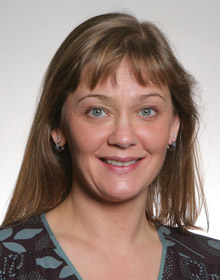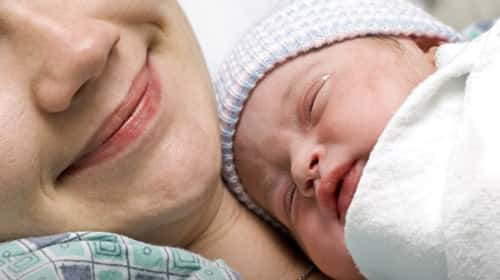Welcoming a healthy baby into the world is one of life’s most precious moments. It’s a joyful time that comes with a feeling of accomplishment and wonder, and when the process of giving birth meets the parents’ expectations, it’s even more rewarding. Delivering that kind of satisfaction is the ultimate goal for the North Bay’s hospitals, and to achieve it, they are embracing knowledge and practices that focus on the physical and emotional health of mothers and their newborns, while also meeting their medical needs and keeping them safe. It’s a change in the approach to childbirth that recognizes individual differences and desires. Natasha Kahl, M.D., director of high risk obstetrics – Sutter Santa Rosa Regional Hospital and chair of the department of Ob-Gyn/Pediatrics at Sutter Santa Rosa Regional Hospital, observes that the childbirth preparation models of the 1970s, when many of today’s grandmothers were giving birth, tended to be rigid. The Bradley and La Maze methods were predominant, and they primarily stressed deep breathing during labor and delivery with the support of a partner. Now though, “Conventional wisdom is that not one size fits all,” she says, and the result is a variety of choices for childbirth as well as preparations for it.
Choices
For first-time parents, having a baby is an experience with lots of unknowns, and one of the first steps is deciding on a hospital. It could be one where a woman’s physician has privileges, such as Sutter Santa Rosa Regional Hospital, so it’s predetermined, but the services it offers could also be a factor. “People seek out our facility in particular, based on our NICU (Neonatal Intensive Care Unit) level, reputation for

maternity care in this community and our facility,” says Kahl. In addition, having an obstetrician available 24 hours a day is an important consideration, especially if a pregnancy is high-risk.
The facilities for families are also a consideration. Hospitals have changed, and unlike days past, when a woman moved from one room to another for labor, delivery and recovery, sometimes in shared accommodation, now hospitals offer private rooms for all three stages.
If parents-to-be are shopping for a hospital, they have several ways to get information. Ricci Ros, director of women’s and children’s services at Santa Rosa Memorial Hospital, which remodeled in 2016, finds that old-fashioned word of mouth is valuable. “Friends have come and liked the care,” she says, and they make recommendations. And at Kaiser, Rebecca Taylor-Ford, director for maternal child health, sees patients who were born at the hospital returning to have their own children there, making it a family tradition.
Websites also provide extensive information. A search might reveal that a hospital has won an award, for example, and that shows its strengths. Marin General Hospital is designated one of only 414 official Baby-Friendly birth centers in the country and received the honor for its practices in caring for newborns, while Kaiser Permanente Santa Rosa Medical Center earned a Women’s Choice Award for patient satisfaction. Hospital websites also list the resources they offer, from prenatal childbirth education classes to podcasts for lactation support, and websites such as Yelp give ratings on hospitals and their outcomes. In addition, apps are popular in a phone-dependent world. “I have patients come in every visit with their apps. I think it’s part of practicing medicine in the 21st century,” says Kahl, who finds that it starts with fertility apps and continues through pregnancy.
Kaiser offers a pregnancy app, and physicians help patients log in and get started. Taylor-Ford explains that it provides general information about pregnancy, as well as developmental milestones in utero. In addition, it provides newborn and pediatric information for use once the baby is born.
Anne Lupus, director of women’s, infants’ and children’s services, reports that Marin General Hospital has a partnership with Wildflower, a company that Leah Sparks, a Marin mom, started, after she recognized the need for women to have access to information and resources from their homes or anywhere they might be during her own pregnancy. The result was the GROW app, which MGH patients can download for free. Users can put in information for every member of the family, enter appointments and get general information and articles, as well as the hospital’s resources for pregnant women. Wildflower reports that families who take advantage of the app use it 10 or more times a day.
Birth plans
Once she’s settled on a hospital, the next step for a woman is to make a birth plan, outlining her preferences for labor and delivery. With private rooms, a woman can usually have as many people as she likes present at any stage of the birth. Taylor-Ford finds that some new mothers want everyone there, including other children, while others prefer only a spouse or significant other with them. “They just want it to be very quiet,” she says. Yet others want just their labor nurse, midwife team or a doula at their side to provide emotional, physical and informational support, and Kaiser honors their wishes. The only time

limitations are imposed is if a woman needs a cesarean section, because then she has to undergo surgery.
Hydrotherapy is an option at some hospitals. Julie Moxley, a lactation specialist at MGH, reports that tubs for labor are popular with Marin patients, and when the hospital’s new building is completed, it will have one in every room. “Water is something that relaxes you.” According to Moxley, water takes away some of the discomfort of being pregnant and allows a woman to relax.
Kaiser also offers hydrotherapy, but in the shower, which allows more mobility, and women can use birthing balls and positioning devices to make themselves comfortable during contractions. Ros reports that Santa Rosa Memorial does not have tubs, but is looking into the possibility. Sutter, on the other hand, has ruled them out entirely. Kahl explains that submersion in water can alleviate pain in the first stage of labor, prior to pushing and delivery, and labor tubs were included in the hospital’s design. However, they wanted equipment that would drain quickly if an emergency occurred, because getting a mother out of a tub can be challenging. “We were not reassured about how quickly these tubs drained,” she said. As a result, installation did not go forward, though the tubs had arrived at the loading dock. No hospitals in the North Bay offer water deliveries, and Kahl explains that they can lead to complications for the baby, such as infection with water-borne bacteria.
Pain relief is always an issue, and the newest trend is the use of nitrous oxide, a compound dentists use, but in a lower concentration—50 percent nitrous oxide and 50 percent oxygen. Kaiser Permanente was one of the first facilities to use it in Sonoma County, and it’s piped into the walls for easy access. “It’s old, and it’s new again,” says Taylor-Ford, explaining that it reduces anxiety as well as helping a woman to cope with pain during labor by breathing it in through a mask 20 to 30 seconds before a contraction begins. It leaves the blood stream as soon as a patient removes the mask, and “It’s a safe therapy,” she says, adding that whether a woman uses it depends on her personal preferences. MGH also offers nitrous oxide, and Sutter plans to implement its use in 2018. Ros reports that Santa Rosa Memorial is in the process of getting funds approved for use in 2018.
“We’re [also] looking at alternative pain management,” says Ros, and that includes the use of birthing balls and peanut-shaped positioners that a woman places between her legs to provide comfort during labor. “We’re trying to help women deliver on their own terms, she says. “We don’t want to over-medicalize birth, if it’s not necessary”
On arrival
Another set of preferences comes into play with a baby’s first cry. Among the current practices is immediate breastfeeding, since it offers significant benefits for both mother and child and creates a special bond. Kahl reports that breastfeeding within the first hour results in better neonatal outcomes and helps with a baby’s temperature and glucose regulation, and MGH’s Moxley explains that mother’s milk is the perfect food for an infant. It provides nutrients for a strong immune system, reduces the risk of diabetes and osteoporosis and contributes to overall good health. A further advantage is that nursing helps protect a woman from

breast cancer.
Though breastfeeding is a natural process, “It’s really a culture change,” says Lupus. Breastfeeding wasn’t common during the 1950s and 1960s, she adds, when the use of formula was prevalent. If new mothers come from families that never breastfed, they are learning about it from hospitals rather than family members. To help them succeed, all of the North Bay hospitals that deliver babies offer lactation support, either one-on-one with a coach or through a support group, and MGH also has a podcast that women can access anytime. She adds that it’s important for the entire hospital to embrace the change, because nursing mothers are everywhere—in labs, emergency rooms and throughout the hospital.
Also new is skin-to-skin bonding, which involves placing the baby on the mother’s chest immediately after birth, thus relating it to breastfeeding. If the nurses need to examine a newborn, they can do everything they need to with the baby on the mother’s chest, as long as the baby is doing well, according to Lupus. She adds that it gives new parents a chance to recognize cues and learn how to feed the baby so they can go home feeling confident. “It’s really a way to empower them to feel confident as parents,” she says.
Kahl explains that physical contact with a mother is also the best temperature regulator for a baby, both in utero and immediately on the chest, and foregoing bathing the baby right away avoids temperature loss as well. In addition, an immediate weigh-in on a cold scale is unnecessary because baby warmers do the job automatically, and weight isn’t needed right away unless a baby requires medication.
Taylor-Ford finds that bathing is often cultural, almost ritualistic, and Kaiser leaves it up to the parents. If bathing is their preference, she says, we honor that as long as it’s not unsafe for the baby. In contrast, some parents want to wait 24 hours after delivery or simply dry the baby off and go home without a bath at all. “That’s completely acceptable, too.” She adds that evidence shows that waiting at least six hours results in positive outcomes, and so they give each new mother an informational handout and find out what her preferences are.
Getting better
Not all pregnancies and deliveries go according to plan, and sometimes surgical intervention is necessary. Kahl observes that the cesarean section has revolutionized neonatal outcomes compared to 100 years ago, and it’s better for mother and child in some cases. It is, however, a complex topic. “Cesareans can make a more challenging transition for the baby,” she says, explaining that the labor process is for the baby as well as the mother, and babies who haven’t gone through the birth canal have a higher rate of fluid in the lungs. For the mother, it requires cutting through tissue and carries a risk of blood loss, and it can affect future pregnancies, especially if a woman hopes to give birth vaginally in a subsequent pregnancy. “If you can avoid that first cesarean, it becomes less of an issue,” says Kahl. Local hospitals have all been successful in lowering the rate, and Kahl attributes better fetal monitoring as one reason for the improvement.
Sutter does not do vaginal births if a woman has had a cesarean, and Kahl points out that it’s a practice that carries a slightly higher risk, because the scar on the uterus could open during labor. It’s uncommon, though, and national safety protocols are in place to avoid complications, and hospitals that do allow VBACs have to meet guidelines for providing safe care.
Kaiser, MGH and Santa Rosa Memorial Hospital all do VBACs (vaginal birth after cesarean) and report good results. Kaiser assists with several a month, and Taylor-Ford explains that it’s the mother’s preference after careful counseling with her physician or midwife. “If they want to try it, OK. We have a specific care plan for those individuals,” she says. Santa Rosa Memorial also offers VBAC, with a high success rate, as does MGH.
Evolution
Obstetric medicine is constantly advancing, but it has its challenges. “No pregnant women are going to volunteer for drug trials,” Kahl points out, so it’s difficult to develop medications for complications. She sees progress, nonetheless. A generation ago, women with type 1 diabetes were told they could never have children, because it wasn’t safe. But now women with such conditions, as well as those who’ve had cancer and organ transplants, are having successful pregnancies. “We’ve come leaps and bounds,” says Kahl.
Research is ongoing and is likely to make many more positive outcomes possible. It’s a new, baby-friendly world that continues to evolve, but in the end the goals are always the same: healthy babies, happy moms and the joy of creating a family in the most positive environment possible. And those values are timeless.
Maternal Health in the U.S.
The United States has the highest rate of maternal mortality in the developed world. Save the Children’s 16th annual State of the World’s Mothers report in 2015 ranked the United States 33rd, while Norway, Finland and Iceland took the top three spots. The Center for Disease Control and Prevention reports that risk for maternal death in the United States is one in 1,800 and on the rise, increasing from 7.2 per 100,000 live births in 1987 to 17.8 in 2009 and 2011. Top causes are cardiovascular disease, non-cardiovascular disease, infection or sepsis and hemorrhage. In addition, the United States ranked 61st in maternal health.
Source: State of the World’s Mothers, 2015
Quality Care
The California Maternal Quality Care Collaborative was founded at Stanford University School of Medicine in 2006 in partnership with the State of California to address rising maternal mortality and morbidity rates. By 2013, maternal mortality had declined more than 55 percent.
It allows more than 200 participating hospitals to network, ask questions and share their best practices and gives them access to the Maternal Data Center, a web resource that generates real-time data and metrics on maternity care services for members of the collaborative. Marin General Hospital, Kaiser Permanente Santa Rosa Medical Center, Petaluma Valley Hospital, Santa Rosa Memorial Hospital, Sutter Santa Rosa Memorial Hospital and Queen of the Valley Medical Center in Napa, are all members.
Source: California Maternal Quality Care Collaborative
Midwives
Normal
0
false
false
false
EN-US
JA
X-NONE
Midwives are popular in the North Bay, and most hospitals use their services. Certified nurse midwives, with special training in obstetrics, perform a large number of Kaiser Permanente’s uncomplicated vaginal deliveries in Santa Rosa, and a doctor is on hand to oversee care 24 hours a day, should complications occur. “People love having midwives,” says Rebecca Taylor-Ford, she adds that midwives have been on the team for 30 years and are now delivering a second generation of babies.
“We have a lovely group of midwives,” says Ricci Ros of Santa Memorial Hospital. Having them practice in a hospital has its advantages, she adds, because staff members trained to deal with emergencies are on hand, if they’re needed. “If anything goes wrong, you’re protecting the life of your child,” she says. “If you need a backup plan, you can get to it very rapidly.”
Midwives do 50 to 60 percent of births at Marin General Hospital, and a study shows that they help reduce the rate of cesarean sections.
Sutter Santa Rosa Regional Hospital has representatives from various medical practices deliver babies, but midwives don’t fit into the model.
Changes in Care
Kaiser Permanente Santa Rosa Medical Center
Rebecca Taylor-Ford believes that obstetrics is gaining greater recognition, as is women’s healthcare, especially in California. She points out that the United States doesn’t have great maternal mortality statistics, but they are decreasing, and she finds it inspiring to see California at the forefront of progress.
Marin General Hospital
Julie Moxley sees a decrease in the number of cesarean sections and an increase in the number of vaginal deliveries after cesarean. She attributes part of the improvement to women themselves, because they’re healthier.
Santa Rosa Memorial Hospital
Ricci Ros finds that the community is more diverse, and so Santa Rosa Memorial offers services in Spanish, as well as English. She also sees more women who are in drug recovery programs or actively using, and staff members treat them well, without bias, while trying to get them into treatment programs before delivery.
Sutter Santa Rosa Regional Hospital
Natasha Kahl, M.D., reports that the age of expectant mothers has changed, with more in their 30s and 40s, partly because of the advent of fertility drugs.
Wendy Boyer observes that newborns who arrive at an early gestational age have a greater chance of survival, thanks to neonatal intensive care units that specialize in their care. The earliest extreme pre-term delivery she’s seen is a baby born at 24 weeks.
 maternity care in this community and our facility,” says Kahl. In addition, having an obstetrician available 24 hours a day is an important consideration, especially if a pregnancy is high-risk.
maternity care in this community and our facility,” says Kahl. In addition, having an obstetrician available 24 hours a day is an important consideration, especially if a pregnancy is high-risk. limitations are imposed is if a woman needs a cesarean section, because then she has to undergo surgery.
limitations are imposed is if a woman needs a cesarean section, because then she has to undergo surgery. breast cancer.
breast cancer.



